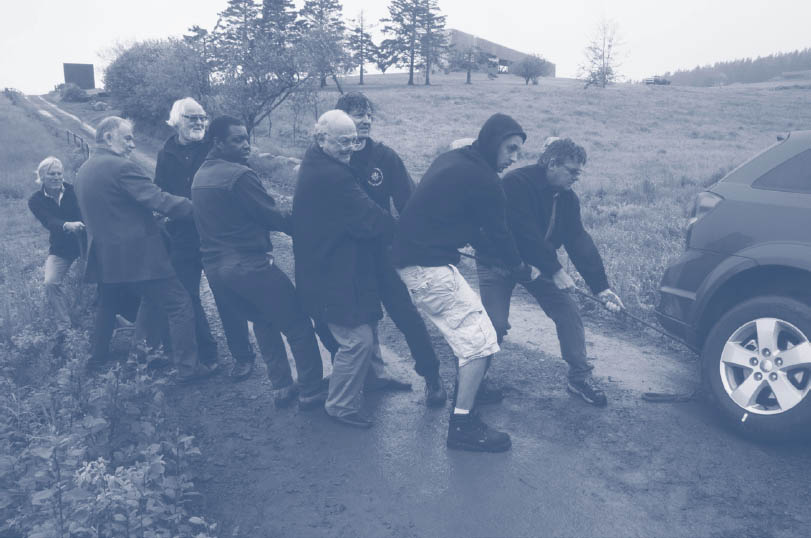
Teamwork: Ghost 13 speakers gather to help a colleague pull her car out of a pond.
This book and the conference that it documents have been a labor of love for me over the past few years—love for architecture and love for the community of colleagues and friends who have made them possible. One morning over breakfast in 2009, when Glenn Murcutt received the AIA Gold Medal in Washington, D.C., I asked him if the unconditional generosity among the architects whose work is featured here is typical in the history of our discipline. He answered that, in his view, it was and is unique.
First among these colleagues is my partner Talbot Sweetapple, who acted as master of ceremonies at the conference and who supports these distractions from the business of our practice. Thanks to historian Robert McCarter, who has worked closely with me on this book as editor from start to finish.
Thanks to editors Megan Carey and Meredith Baber; designer Elana Schlenker; and Publisher Kevin Lippert of Princeton Architectural Press. Their intelligent, critical perspectives have reinforced the value of the longstanding working relationships that many of my colleagues and myself have enjoyed with the press.
Thanks to my assistants at MacKay-Lyons Sweetapple Architects: Lisa Morrison, who helped to organize the conference in 2011; Frances McGinnis, who began working on the book; and Lindsay Ann Cory, who brought it to fruition.
Father Michael Mitchell and the wardens of St. John’s Anglican Church in Lunenburg generously provided the magnificent, carpenter gothic venue for the conference’s three keynote lectures. The design/build efforts of Ghost Architectural Laboratory participants over the years have shaped the venue for the conference at our farm. Scott Geddes of Coco Pesto catering kept our bellies warm during that cold, wet June of 2011, as he has for many years of Ghosts.
No one who attended the conference will ever forget that first stormy morning when, just before Rick Joy’s frozen fingers could start his presentation, we suddenly lost power. Within minutes my Acadian/Micmac friend, Barnell Duffenais, came flying over the hill with his truck and generator. We were soon back in business. When I thanked him he answered, “no problem buddy; the day that I can’t help you out is the day I am dead.” So, I like to say that in Nova Scotia, it is not the Calvary, but the Natives who come over the hill to save your butt.
Special thanks to Brigitte Desrochers, who believed in the importance of local architecture for our discipline, and the Canada Council for the Arts, for its generous support for both this book and the conference.
At the end of “Ideas in Things,” I asked Juhani Pallasmaa for his advice on the future of the Ghost Lab. He suggested that it was time to take a break, because “it is the hospitality of your family that is the quality that makes Ghost special, and the most costly element.” The conference, this book, our practice, and the paradise at the end of the earth that is the Ghost venue and our home have been sustainable mainly because of the unconditional support of my family—Marilyn, Renee, Alison, and Matthew. They are the ones who clean the toilets, haul the wood for the bonfire, and make our guests and friends feel at home.
And lastly, thanks to Darwin, the now departed bottle-fed lamb, who enjoyed peeing on the floor at the lectern, keeping the distinguished speakers down to earth.
—Brian MacKay-Lyons